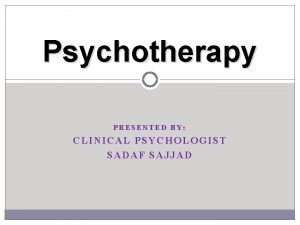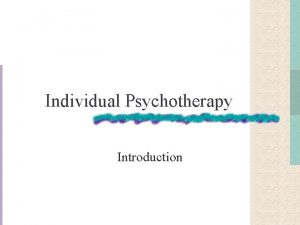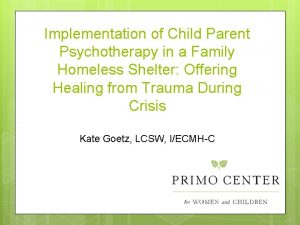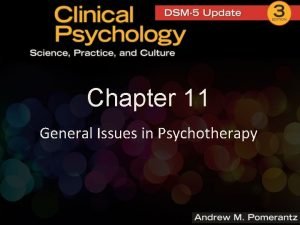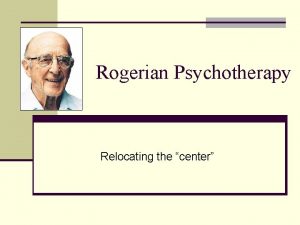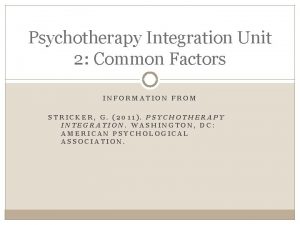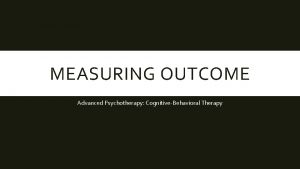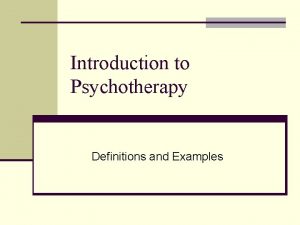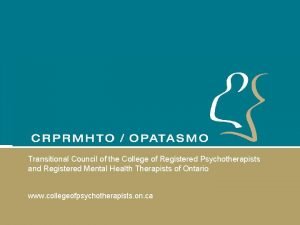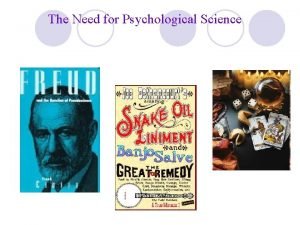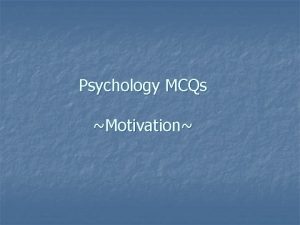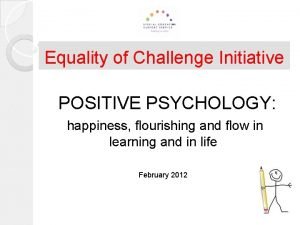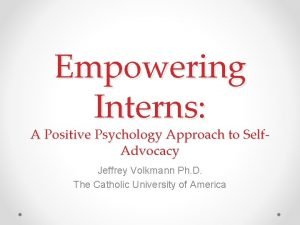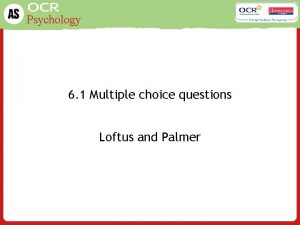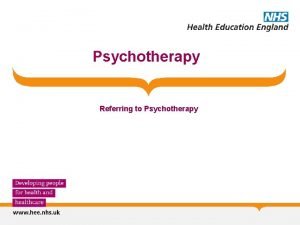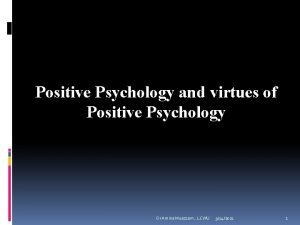AN OVERVIEW OF POSITIVE PSYCHOLOGY AND GOALACHIEVING PSYCHOTHERAPY

















































- Slides: 49

AN OVERVIEW OF POSITIVE PSYCHOLOGY AND GOAL-ACHIEVING PSYCHOTHERAPY (GAP) Ronald S. Kaiser, Ph. D. , ABPP Licensed Psychologist Clinical Associate Professor, Department of Neurology Thomas Jefferson University, Philadelphia, PA Jefferson Headache Center

Part 1 WHY ARE WE HERE?

Influences on becoming a therapist • Orientation of your academic program • Your family • Everything else

Self-disclosure about influences • • Jim Murray Don Meredith Dr. Ben Shimberg Structural/Strategic Family Therapy The gym The arrival of positive psychology The internet

Exercise Who and what influenced you?

Reasons for taking this workshop • November 30 th is approaching. • Ethics requirement is completed. • I was already here for another workshop.

Part 2 INTRODUCTION TO POSITIVE PSYCHOLOGY

Historical roadblocks to a positive psychology • The evolutionary negativity bias. • The early medical model: Wellness=Absence of disease. • ICD, DSM, MMPI, NIMH funding. • Definitions of psychotherapy typically involve the treatment of mental disorders or problems.

…as a result PSYCHOLOGY HASN’T GIVEN A LOT OF ATTENTION TO THOSE ON THE HEALTHY END OF THE CONTINUUM

Positive psychology exists on a different continuum • The goal is positive rather than neutral • The emphasis is on well-being, thriving, flourishing

Positive Psychology: A byproduct of a newer scientific age • • Brain plasticity Mindfulness Physical exercise Mental exercise Social involvement Health psychology Aging

THE SPECIAL ROLE OF BRAIN PLASTICITY • The historical belief was that after childhood the brain could only change in one direction – Decline. • Hardwiring: the concept that the brain was more like a computer than a muscle. • Research has dramatically changed this

RESEARCH ON THE CHANGING BRAIN • Taub’s Constraint Induced (CI) Movement Therapy. • Competitive plasticity and Merzenich’s brain mapping. • The role of mental rehearsal (Pascal-Leone’s piano students). • Maguire’s research on the posterior hippocampuses of London taxi drivers (Maguire, Current Biology, 2011).

THE ROLE OF PHYSICAL EXERCISE • What did Freud, Rogers, Skinner, Ellis, etc. have to say about exercise? • What have Seligman, Achor, and other positive psychologists said about exercise? • Mac. Arthur Foundation studies demonstrate 3 ways of reducing cognitive decline (normal weight, lifelong learning, exercise) • Studies demonstrate that if you are middle-age and sedentary and you start a regular exercise program, you can delay the onset of cognitive decline by 10 -15 years (Ratey; Kramer). • Naperville, IL, 8 th graders finished #1 in the world in science & 6 th in math after being involved in a comprehensive daily PE program.

THE SEMINAL ARTICLE • Seligman, M. , & Csikszentmihalyi, M. (2000). Positive psychology: An introduction. American Psychologist, 55 (1), 5 -14.

POSITIVE PSYCHOLOGY DEFINED • Psychology is not just the study of pathology, weakness, and damage. It is also the study of strength and virtue. • Treatment is not just fixing what is broken. It is nurturing what is best.

Pioneers of the positive psychology movement • Ed Diener (Dr. Happiness) • George Vaillant (longitudinal study of aging) • MIHALYI CSIKSZENTMIHALYI (Flow) • MARTIN SELIGMAN • Barbara Fredrickson (Broaden and Build) • *Christopher Peterson (Values in Action)

Positive Psychology concepts include: • • • Happiness Gratitude Resilience Flow Grit Curiosity Goals Well-Being PERMA (Positive Emotion; Engagement; Relationships; Meaning; Accomplishment)

CHARACTER STRENGTHS AND VIRTUES • Positive Psychology’s answer to diagnostic manuals • VIA Survey of Character Strengths (and many other inventories can be taken at www. authentichappiness. com

CHARACTER STRENGTHS AND VIRTUES • Unlike the ICD and DSM, this is “A Manual for the Sanities”. • The focus is on what is right about people rather than what is wrong. • Based on substantial research across cultures.

EXERCISE What are things that you like the most about yourself?

POSITIVE PSYCHOLOGY EXERCISES • The What-Went-Well (or 3 Good Things or 3 Blessings) Exercise • The Gratitude Visit • The 20 second rule • The Reverse 20 second rule • The Modified Presidential Campaign Assessment

Positive Psychology: A creature of academia • Unlike almost every other approach to therapy (except behavioral), the major theoretical concepts were not developed out of practice. • Much of Positive Psychology consists of exercises and structured approaches that can be applied in therapy, coaching, and through self-study. • Goal-Achieving Psychotherapy is one of the few models developed to be incorporated into therapy as it’s done in the real world.

…but there is an impressive body of research

POSITIVE PSYCHOLOGY AND HEALTH • Positive psychological well-being is associated with: Fewer colds Reduced mortality in both healthy & ill populations Reduced cardio-vascular disease Reduced mortality from CVD , renal failure, & HIV • Findings with respect to cancer are more equivocal • No study has demonstrated a relationship between pessimism and better health or reduced mortality.

Happinesss and Success • Numerous studies reflect the fact that happiness and optimism precede success much more often than the other way around. (Achor, 2010) Students Salespeople Physicians

MEASURES OF POSITIVE INTERACTIONS • The Losada Line and Ratio • The Fredrickson Positivity Ratio

THE IMPORTANCE OF THE SOCIAL NETWORK • Strength of social relationships is the major distinguishing characteristic of the happiest 10 % of the population. (Diener & Seligman, 2002) • There are “ 70 years of evidence that our relationships with others matter, and matter more than anything else in the world. (Vaillant, 2009)

THE IMPORTANCE OF A SOCIAL NETWORK • Other people matter. Christopher Peterson You should always go to other people’s funerals; otherwise they won’t come to yours. Yogi Berra

Part 3 An introduction to Goal-Achieving Psychotherapy

PRINCIPLES AND PRACTICES OF GAP (1) • The approach is forward looking and positive. • The approach is geared toward building personal strengths to manage change and growth. • The focus is primarily on the solution, not the problem. • The past is meaningful – especially as it relates to character strengths and achievements. • The therapist is active, directive, supportive and a cheerleader for growth and change.

PRINCIPLES AND PRACTICES OF GAP (2) • The patient/client is active in preparing a Mission Statement and setting an achieving goals. • Goal setting is designed to ensure maximum success by utilizing small and measureable forward steps. • Wallowing is avoided. • Activity is the default. • Once positive commitment and direction is implemented, other forms of therapy can be incorporated. • Positive personality change can take place throughout the life span.

PRINCIPLES AND PRACTICES OF GAP (3) • The Type P Personality is the model of the healthy personality. • Emotional health is always a work in progress. • GAP principles can be pursued on a do-it-yourself basis, in therapy, or through coaching – depending upon your needs at any specific time. • GAP-specific materials are available to aid in the implementation and maintenance of progress. • www. thementalhealthgym. com is the ongoing source of GAP resources and information.

THE GYM AS A MODEL • Wellness is the central concept • Emphasis on building the core – the psychological infrastructure • All shapes and sizes can benefit to different degrees • Goals are individual and measureable • Diagnosis is descriptive, not prescriptive

THE INTRODUCTORY SESSION • Understanding the reason for treatment • Expression of therapist gratitude as part of informed consent • Explanation of process and philosophy • History-taking within the context of strengthbuilding • Introduction to the role of activity level and homework

THE ROLE OF HISTORY • Establish early the importance of moving forward to develop strengths. • Identify unhappy aspects of history – to primarily use in the future. • Identify positive aspects of history. “When was the best time in your life? ” “What things do you like most about yourself” “What makes you so resilient? ” Be prepared to revisit history from a position of strength.

GETTING UNSTUCK: THE CRITICAL QUESTIONS 1. 2. 3. 4. Are you a fortune teller? What can go right? What does this have to do with you? How is this getting you where you want to go? 5. What will you do now to maintain your success?

GAP ASSESSMENT ALTERNATIVES TO TRADITIONAL DIAGNOSIS • Competent Person’s Disease – “the addiction to 2 nd place” • The “Too Excuse” – Carol Dweck’s concept of the Fixed Mindset • Over-thinking • Under-rating (A/Fail thinking: Ascribing unimportance to achievements; Luck) • Question changing

THERAPEUTIC CONSIDERATIONS • The therapist as a role model • Phone calls • No shows • Suicidal ideation or threats • Patient sabotage • Session intensity

THE TECHNIQUES OF GAP Vision without execution is hallucination. Thomas Edison

BUILDING THE PSYCHOLOGICAL INFRASTRUCTURE (or CORE) Self-acceptance + achievement of goals = “Taking yourself back to you”

The Mission Statement • Current behavioral commitments and goals Benefits of achieving your goals Impediments Strengths to overcome impediments • Areas for change and growth Health and fitness Cognitive functioning Social

EXERCISE Write YOUR mission statement

SUPPLEMENTAL MATERIALS & TECHNIQUES • Exercise Cards • Create Your Proactive Positive Explosion Form • Type P Personality Development Form DEFAULTS ARE ACTIVE

TYPE P PERSONALITY • • • Personal goal-directed Proactive Positive Persistent Playful

THE TYPE P PERSONALITY • The ultimate goal • Assessment is done throughout the process • Roughly comparable to PERMA

SUCCESSFUL APPLICATIONS OF GAP TO SPECIAL POPULATIONS • • • Some Axis II populations Habit control Depression PTSD Adolescents Headache patients

WHY DOESN’T IT WORK FOR EVERYONE? • Nothing does. • Expectancy of therapy as a place to wallow may not be met. • Using the gym as a model, it is notable that people who drop out may some day return. • Intensity and/or homework turn some people off. • It’s still a work in progress without a lot of external input.

THANK YOU! • • Your comments are important to me. Please feel free to contact me at ronald. kaiser@jefferson. edu 215 -955 -2743 Or ron. kaiser@thementalhealthgym. com 215 -704 -0983
 Counterconditioning psychology
Counterconditioning psychology Psychotherapy definition psychology
Psychotherapy definition psychology Positive psychology ap psychology definition
Positive psychology ap psychology definition The difference between guidance and counseling
The difference between guidance and counseling Dodo bird verdict psychology
Dodo bird verdict psychology Counselling psychology
Counselling psychology What is educational psychology discuss its nature and scope
What is educational psychology discuss its nature and scope S. agalactiae catalase test
S. agalactiae catalase test What's 8 + 5
What's 8 + 5 Positive practice positive outcomes
Positive practice positive outcomes Andrew pethebridge
Andrew pethebridge Types of individual psychotherapy
Types of individual psychotherapy Cpp triangle of explanation
Cpp triangle of explanation Cognitive psychology ppt
Cognitive psychology ppt Bracketing skills
Bracketing skills General issues in psychotherapy
General issues in psychotherapy Carl rogers theory
Carl rogers theory Psychotherapy refers to
Psychotherapy refers to Individual psychotherapy definition
Individual psychotherapy definition Quantum psychotherapy
Quantum psychotherapy Behavioral disputation
Behavioral disputation The common factors approach to psychotherapy integration:
The common factors approach to psychotherapy integration: Types of psychotherapy
Types of psychotherapy Advanced psychotherapy
Advanced psychotherapy Psychotherapy examples
Psychotherapy examples Limitations of psychotherapy
Limitations of psychotherapy College of registered psychotherapists of ontario
College of registered psychotherapists of ontario Transference
Transference World council for psychotherapy
World council for psychotherapy Example of positive correlation in psychology
Example of positive correlation in psychology Positive psychology mcqs
Positive psychology mcqs Computer metaphor in cognitive psychology
Computer metaphor in cognitive psychology Concepts of positive psychology
Concepts of positive psychology Positive psychology 1504
Positive psychology 1504 Strath haven positive psychology curriculum
Strath haven positive psychology curriculum Classical conditioning
Classical conditioning Positive psychology baumgardner
Positive psychology baumgardner Meaningful life positive psychology
Meaningful life positive psychology Humanistik maslow
Humanistik maslow Second wave of positive psychology
Second wave of positive psychology History of positive psychology
History of positive psychology What are primary and secondary reinforcers
What are primary and secondary reinforcers Signature strengths
Signature strengths Positive psychology internships
Positive psychology internships Positive psychology multiple choice questions
Positive psychology multiple choice questions Social psychology definition psychology
Social psychology definition psychology Fundamental attribution error ap psychology
Fundamental attribution error ap psychology Scope of psychology
Scope of psychology Social psychology definition psychology
Social psychology definition psychology Health psychology definition ap psychology
Health psychology definition ap psychology

